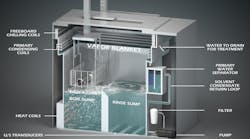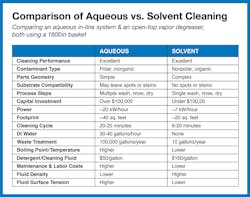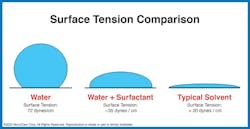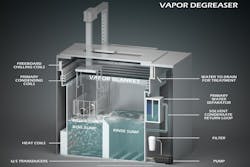Today, most metal fabricators and machine shops have two parts-cleaning options: aqueous water-based cleaning or solvent-based cleaning inside a vapor degreaser. Both methods can provide quality cleaning results. However, each has its distinct drawbacks and advantages.
Aqueous or water cleaning is a process that uses water and chemical additives to get parts clean. The water is treated with detergents or surfactants, builders, emulsifiers, saponifers, sequestering agents, chelating agents and a variety of other compounds to boost the cleaning performance. Using a three-step process, parts are washed in a series of machines, followed by a secondary rinse step to carry away any detergent residue. Then a third step dries the parts using hot air knives or isopropyl alcohol. Aqueous cleaning works with a combination of detergents, high heat and agitation, also known as ultrasonics, to break down soils and remove them from the parts surfaces.
Depending on the reactive additives incorporated into the water, the cleaning agent can be very mild or very strong and can range from nontoxic to dangerous. Some of the additives can be very aggressive on different metals, plastics or inks, so all parts materials must be tested for compatibility prior to cleaning. In addition, the parts should be tested post-cleaning to ensure no reactive material is left behind from the rinse process. After cleaning, the wastewater is filtered, distilled, deionized and osmosis prepped for disposal.
Aqueous cleaning works well and is particularly useful when combining the cleaning process with other procedures, such as depositing rust-preventers and brightener coatings.
Solvent-based cleaning cleans, rinses and dries parts in just one step inside a single machine. Parts are placed inside a vapor-degreasing machine filled with a solvent-based cleaning fluid. Most solvent-based cleaning fluids are a mixture of compounds that can include hydrocarbons such as mineral spirits, isopropanol and ethanol. How the compounds are combined determines the cleaning fluid’s effectiveness and its material compatibility. The vapor degreaser can use just one type of cleaning fluid or can be mixed, blended or custom formulated to remove a specific soil from a specific substrate, maximizing cleaning effectiveness.
Parts are immersed in the continuously filtered and distilled cleaning fluid to dissolve the soils from the parts surface. In some instances, ultrasonic agitation is added for additional cleaning muscle. No additional detergents or additives are needed to dissolve the soils. As the parts are removed from the cleaning fluid, they undergo a brief vapor rinse and drying process. The cleaning fluid condenses and drips back into the vapor degreaser to be reused. The vapor degreaser reuses and recycles the cleaning fluid hundreds of times before it needs to be refreshed or replaced. This helps reduce the cost of hazardous waste removal. The parts come out clean, rinsed, dried and ready for the next stage of production.
Since the cleaning, rinsing and drying are done in one machine, the vapor degreaser cleans a high volume of parts quickly (about 6-20 min.). Plus, the cleaning fluid boils at a lower temperature with less heat than the water in an aqueous system. This translates to greater safety for sensitive parts. The parts also require less drying time, which means less energy usage. Solvent-based cleaning also leaves no residue and dries without stains or spots.
Some of the more popular cleaning fluids used in metal fabricating and machine shops include n-propyl Bromide (nPB), Trichloroethylene (TCE) and Perchloroethylene (Perc). However, many companies are moving away from these older solvents to improved, updated cleaning fluids. The new fluids clean just as effectively, but without the worker safety or air quality concerns of the older solvents. There are a number of good sustainable, low-GWP (global warming potential) and low-ODP (ozone depleting potential) alternatives on the market today.
To determine if aqueous or solvent-based cleaning is better for your particular cleaning task, it is important to not make the decision based on cost alone. You should look at the entire cleaning task and consider all the factors. While there are many things to consider, three main points stand out: the contamination on the parts, the shape of the parts being cleaned and the throughput requirements. All three must work together to deliver the best possible cleaning results.
What is the Contaminant?
There is an old saying in the industry about parts cleaning: “like dissolves like.” So, the best way to remove contamination is to use a cleaning fluid that is chemically similar to the contaminant itself. Contaminants are typically identified as polar (inorganic), non-polar (organic) or particulate.
Polar or inorganic contaminants are soluble in water. In machining, polar soils include salts, soaps, emulsion residue, graphite, and anti-wear and extreme-pressure additives. They also include oxidation, such as rust and tarnish, heat scale, smuts, carbonaceous and metallic compounds. Aqueous cleaners are good at removing these contaminants since the water-based detergents and surfactants emulsify and encapsulate contaminants so they can be washed away.
Non-polar or organic soils are solvent soluble. Therefore, using a solvent-based cleaning fluid is the best choice. Typical non-polar or organic contaminants include halogenated, oxygenated and hydrocarbon soils like machining and stamping oils, thick grease, wax, baked-on resins, corrosion protection agents and esters. They also include things like drawing compounds, spinning lubricants, buffing compounds and fingerprints. Solvent-based cleaning is ideal for these types of soils since the solvent dissolves the contaminants and washes them away.
Particulate includes insoluble contaminants like metal chips, shavings, dust, dirt, soot, surfactants, stearates, fibers, polishing pastes and any other contaminant that will not dissolve in water or solvent-based cleaning fluids. Instead of being solubilized or dissolved, the particulate is displaced or lifted off the components and then washed away. The cleaning fluid gets under the particulate, dissipates the static holding it to the part and floats it off the surface. Displacement cleaning is used in both aqueous and solvent-based cleaning methods.
What is the Parts Shape?
Parts geometry helps dictate which cleaning method is preferred. For example, if a company is cleaning miniature, intricate steel parts with tiny blind holes that are subject to corrosion, then aqueous cleaning might not be the best option. Not only could it be difficult to remove the contaminant out of the tight spaces, but the water may also get trapped inside the parts. Even with adding heat and extensive drying, there is a real risk of water getting trapped and causing corrosion. Therefore, in this particular instance, solvent-based cleaning is a better option.
Solvent-based cleaning fluids have a lower surface tension and are less viscous than water. This means the liquid solvent and the solvent vapors more readily get into—and even more importantly, out of—blind holes and any gaps between stacked parts. Solvents are better at wetting part surfaces and evaporating out of tight spaces.
On the other hand, a company might have very simple parts that need to have heat scale removed. Perhaps the parts are made from aluminum where rusting is not a concern. At that point, aqueous cleaning may be a better choice to remove the heat scale. Aqueous cleaning may also be more appealing if the company already has an aqueous system in its shop and an already established wastewater handling process. At that point it might be easier and more cost effective to use the existing equipment instead of investing in vapor-degreasing equipment and solvent-based cleaning fluids.
What are the Throughput Requirements?
Throughput requirements is the third consideration when determining which cleaning method to use. Aqueous systems typically have longer cleaning cycles due to the need for several washing, rinsing and drying stations. In addition, they may require mechanical spraying and washing systems and higher working temperatures to get the parts to the required cleanliness standard. These added steps take additional time and impact throughput rate. Plus, aqueous systems require the input of chemists and engineers to ensure they are within operating parameters, including prewash conditioning and post-wash water treatment.
In contrast, vapor degreasing is performed quickly and cleans consistently down to the submicron range. It does require filter replacements and the cleaning fluid needs to be periodically boiled down and removed. However, the new next-generation fluids no longer require acceptance testing or scavengers to prevent them from going acid, eliminating the time needed for maintenance.
Environmental Impact
With any cleaning method, the goal is to produce clean parts at the lowest possible cost to maintain profitability and overall business success. However, sustainability should also play a role. The cleaning method must be nontoxic and as safe for workers as possible. Whether aqueous or solvent-based, either cleaning method impacts the environment; you cannot avoid this by switching from one cleaning method to the other. The goal is to minimize water pollution, control emissions and limit waste disposal.
Therefore, when choosing which cleaning method to use, it is recommended that you work with a precision-cleaning expert that specializes in both aqueous and vapor-degreaser solvent cleaning. They can help assess your particular cleaning project and recommend the fluids and process that will work best.
Venesia Hurtubise is a technical chemist at MicroCare Corporation, which offers precision cleaning solutions. Hurtubise researches, develops and tests cleaning-related products used in precision-cleaning and medical applications. For more information, visit www.microcare.com.



